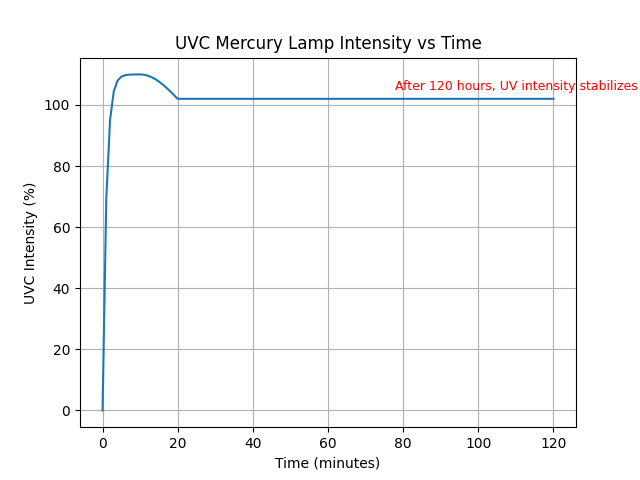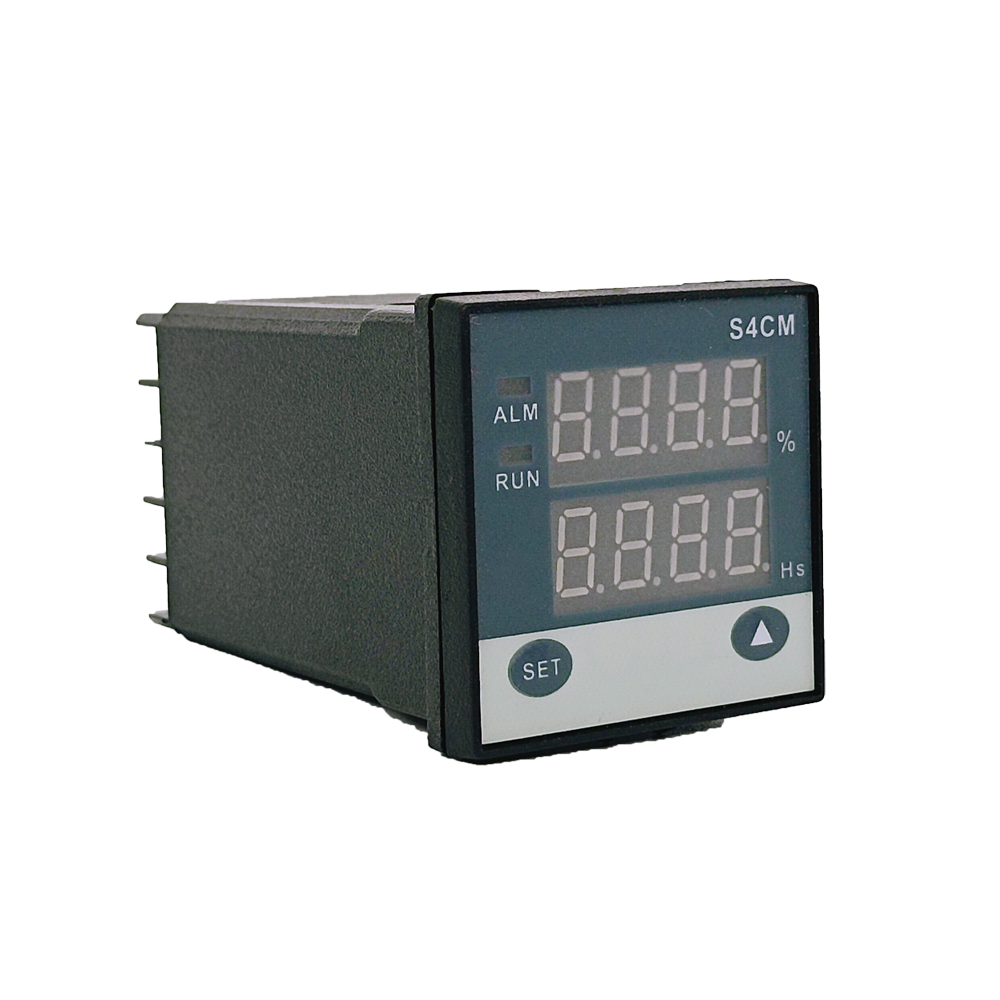Why Does My UV Intensity Reading Decrease Over Time? Understanding UVC Intensity Instability and How to Fix It
If you’re using a UVC intensity monitor or sensor and have noticed that your UV intensity readings are decreasing over time, you’re not alone. Many people experience this issue, especially when working with UVC mercury lamps. But don’t worry, it’s usually not a problem with your sensor or monitor! Let’s explore why this happens and how you can manage and resolve it.
Visualizing UVC Intensity Changes Over Time
To help you understand the intensity fluctuations you may be seeing, here’s a chart that illustrates the typical behavior of UVC mercury lamps over time:

Figure 1: UVC Mercury Lamp Intensity vs Time. This graph shows how UVC intensity fluctuates when the lamp is first turned on and stabilizes after approximately 120 hours.
As shown in the chart, UVC intensity peaks in the first few minutes, stabilizes after 20 minutes, and reaches its final, steady intensity after 120 hours of continuous operation. This is a normal behavior for UVC lamps and is important to understand when monitoring UV intensity.
Understanding UVC Intensity Fluctuations: What’s Going On?
When a UVC mercury lamp is turned on, it doesn’t immediately deliver stable intensity. The UVC intensity fluctuates significantly in the first few hours due to the lamp’s warm-up process and natural degradation over time. Here’s what happens:
-
Initial Fluctuation (0-5 minutes): After turning on the UVC lamp, the intensity peaks within the first 3-5 minutes. During this time, it’s normal for the intensity to be unstable.
-
Stabilization (20 minutes): Within 20 minutes, the UVC intensity will start to stabilize as the lamp warms up and reaches a more consistent output.
-
Final Stability (120 hours): After around 120 hours of continuous operation, the UVC intensity will reach its final, stable output.
Common Causes of UV Intensity Decrease: Why Does It Happen?
It’s important to note that UVC lamps naturally degrade over time. However, several other factors may contribute to significant drops in intensity. Here are the common reasons:
-
Incorrect 100% Intensity Setting Right After Startup: Setting the intensity to 100% immediately after turning on the UV lamp may result in inaccurate readings, as the lamp hasn’t had time to reach its peak intensity. It’s always a good idea to wait for the lamp to warm up (3-5 minutes) before setting the intensity.
-
Low-Quality UVC Mercury Lamp: Cheap or low-quality lamps may degrade faster and lose efficiency over time. This leads to a noticeable decrease in intensity. When choosing a UVC lamp, make sure to buy high-quality lamps to ensure long-lasting performance.
-
Environmental Factors (Temperature Fluctuations): Temperature plays a huge role in the stability of UVC intensity. If your system is operating in an environment with significant temperature fluctuations, this can cause the intensity to vary. Keep the temperature stable to avoid these problems. For instance, if the UV system is placed in an enclosed space where the temperature rises and falls rapidly, you may notice greater intensity changes.
How to Set Your UVC Intensity Sensor and Monitor for Stability
Now that we understand the causes, how can you minimize fluctuations and ensure your UVC system is performing optimally? Here are some tips:
-
Wait for the Lamp to Warm Up: After turning on the UV lamp, wait 3 to 5 minutes for it to stabilize before adjusting the intensity settings. This ensures you are setting the correct intensity level once the lamp has reached its peak.
-
Allow for Long-Term Stability (120 Hours): For the best results, it’s highly recommended to wait for 120 hours of continuous operation before making any further adjustments. This allows the lamp to reach its final stable intensity and minimizes fluctuations.
-
Set the Low-Intensity Alarm Appropriately: You can also configure your UVC intensity monitor or sensor with a low-intensity alarm, but make sure it’s set correctly based on the lamp’s warm-up time and final stable output. This will help you receive alerts if the intensity falls below the desired level.
How Long Do UVC Lamps Last, and Why Do They Lose Intensity Over Time?
UVC mercury lamps typically have a lifespan of 9999 hours. Over time, as the lamp ages, the UVC intensity naturally declines. This is due to several factors, including:
- Lamp degradation: As the lamp is used, its internal components wear down, leading to a decrease in intensity.
- Environmental factors: Poor environmental conditions (temperature, humidity) can accelerate degradation.
For example, after 195 hours of use (around 8 days), it’s not uncommon to notice a slight decrease in intensity, especially if the lamp is not of high quality or the environment is not ideal.
Is It Time to Replace Your UVC Lamp?
If you’ve been using your UVC lamp for a long period (e.g., over 9999 hours) or notice a significant decrease in intensity, it might be time to consider replacing it. Regularly replacing your UVC lamps based on their recommended lifespan ensures your system remains efficient and effective.
Should I Worry About These Fluctuations in My UV Disinfection System?
Generally, no, you don’t need to worry. These fluctuations are temporary and don’t affect the overall performance of your UV disinfection system. After the lamp stabilizes, you’ll get consistent intensity readings, and your system will continue to perform its disinfection tasks effectively.
To keep your UV system working optimally, follow these steps:
- Proper installation and maintenance are crucial.
- Regularly replace lamps according to their lifespan.
- Ensure optimal operating conditions (temperature and power stability).
Introducing the CHS4CM UVC Intensity Monitor with Automatic 100% Intensity Setting

If you’re looking for a solution to minimize the impact of UVC intensity fluctuations and ensure your system stays stable, the CHS4CM UVC Intensity Monitor might be the answer.
This monitor comes with a built-in program that automatically adjusts the intensity setting to 100% 120 hours after lamp startup, helping to reduce instability and improve the overall accuracy of your intensity readings. This feature is especially useful for those who want to avoid manual adjustments and ensure reliable UVC monitoring over time.
Call to Action:
Need help setting up your UVC intensity sensor or monitor? Contact us for expert advice and support!

Leave A Comment